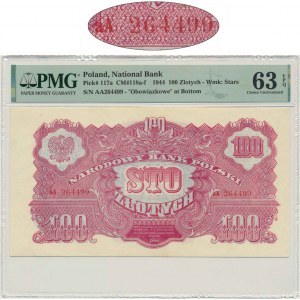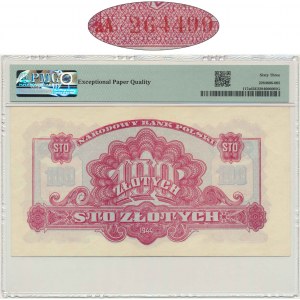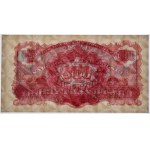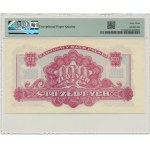One of the rarest banknotes of the communist period.
Extremely rare variety with a "mandatory" clause, marked first with a small and then with an uppercase series letter.
A variety that includes only two series aA and aB.
The banknote bears a PMG certificate with an amazing for this variant, PMG 63 EPQ grade.
This is the best preserved representative of this very rare variety that has been hosted at auctions in Poland. At our auctions, the variety was hosted in 2020 at the 6th SNMW Auction, where a piece with a PMG 55 note was auctioned for 6380 PLN!
Paper money from the first Polish post-war issue designed and printed in the "Goznak" printing house functions in the literature under the name of the so-called "Lublin series". Their issuance and the appearance of their graphic design were decided in Moscow, where they were designed by Ivan Ivanovich Dubasov, the chief graphic designer of the Moscow paper mill.
The first series introduced into circulation contained a grammatically incorrect legal clause. The grammatical errors visible on the banknotes resulted from the mechanical translation of texts from Russian into Polish. The wording was corrected in the second issue of the series. The banknotes of the "Lublin series" featured graphic ornaments in the form of guilloches and floral decoration. On the obverse of each denomination was placed the annual date - 1944. Their format was not uniform and increased with the face value. The first banknotes appeared in circulation from August 26, 1944.
The offered banknote beautiful and absolutely natural. Minor imperfections only on the very tips of the corners.
An ornament of the communist period of our 13th Premium Auction in the Polish paper money section. An extremely rare variant in bank condition that shines a void in many advanced collections. Such a rare variety in such excellent condition guarantees a ton of excitement in the auction room!
In 1944, the Polish lands fell under Soviet influence. In 1944, after the expulsion of German troops beyond the Vistula River, the organization of a new monetary system began. In the conditions of the still ongoing war, the return of the Bank of Poland from London was impossible, and the communist authorities did not agree to maintain the activities of the Bank of Issue in Poland. At the end of August, the Central Treasury Fund was established, which issued paper zlotys with an issue date of 1944. The exchange rate of the zloty was equalized with that of the ruble. In mid-January 1945, the National Bank of Poland was established and took over the duties of the central bank. At the exchange of the Polish Emission Bank's zlotys into NBP zlotys, it was allowed to exchange at a ratio of 1:1 the amount of 500 zlotys for each adult.
In order to restore the country's market balance between monetary circulation, wages and prices, a second monetary reform was necessary. The need for it began to be considered in 1947. At that time, they proceeded to prepare new monetary signs in the form of coins and banknotes to be introduced into circulation.
The monetary reform was introduced by the Sejm with the law of October 28, 1950. At that time, a new monetary unit was introduced with a parity of 1 zloty =
The 1950 money exchange had no restrictions on the amount, but there was a very short time limit on the amount. It occurred in the ratio of 100 old zlotys to 1 new zloty. In 1950, prices and wages were converted at an exchange rate of 100:3. The introduction of such a ratio of old to new zlotys at the exchange resulted in a significant decrease in the real value of money held by the population. Conducting a reform of the monetary system in 1950 was intended to prevent inflation and raise the purchasing value of the zloty.
Paper money from the first Polish postwar issue designed and printed in the "Goznak" printing house functions in the literature under the name of the so-called "Lublin series". Their issuance and the appearance of their graphic design were decided in Moscow, where they were designed by Ivan Ivanovich Dubasov, the chief graphic designer of the Moscow paper mill.
The first series introduced into circulation contained a grammatically incorrect legal clause. The grammatical errors visible on the banknotes were due to the mechanical translation of texts from Russian into Polish. This wording was corrected in the second issue of the series. The banknotes of the "Lublin series" featured graphic ornaments in the form of guilloches and floral decoration. On the obverse of each denomination was placed the annual date - 1944. Their format was not uniform and increased with the face value. The first banknotes appeared in circulation from August 26, 1944.












